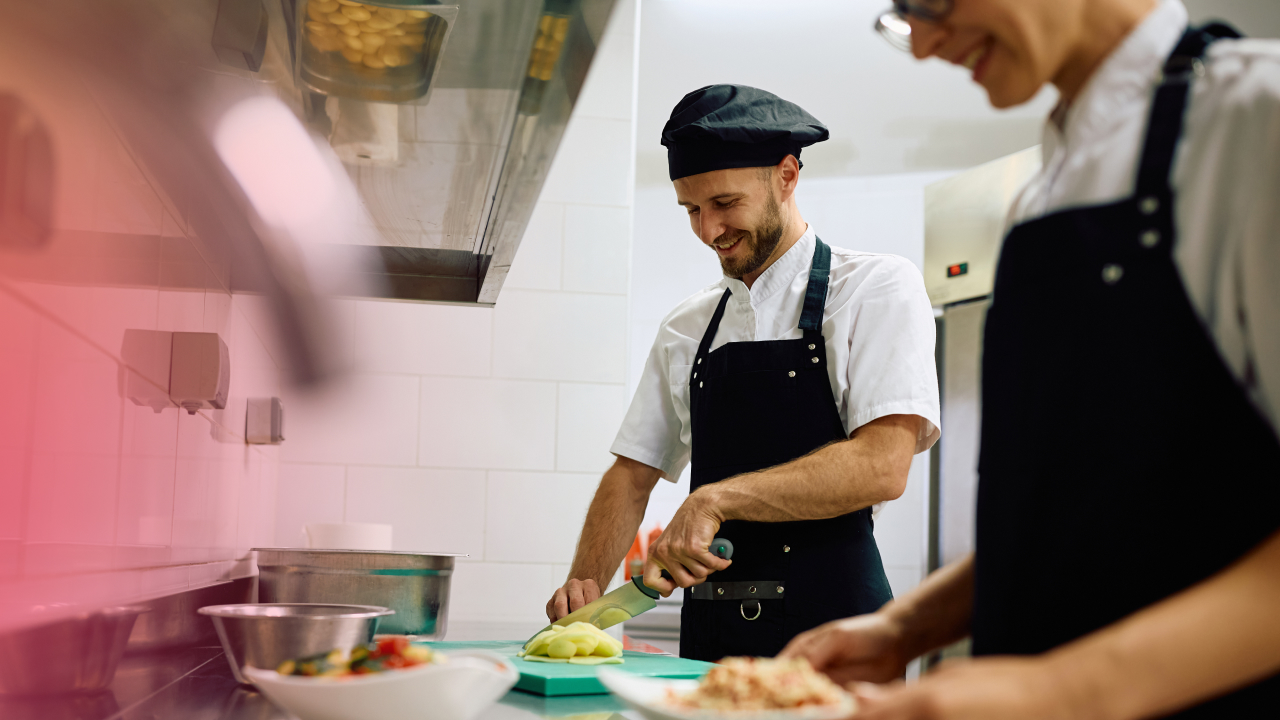Well-defined procedures are crucial for the successful operation of any business, and this is especially true in the fast-paced environment of a restaurant. Without clear guidelines, you run the risk of creating a disorganized and chaotic environment and, most importantly, negatively impacting the experience of your diners. So, what’s the solution? Simple. You need a restaurant SOP. A restaurant SOP (standard operating procedure) provides a clear framework for your bar and wait staff to follow, helping you maintain high standards, enhance operational efficiency, and deliver exceptional dining experiences.
But what is a restaurant SOP and why is it so essential to develop and implement one in your business?
Read on to find out everything you need to know about restaurant SOPs, including what they are and how you can develop your own tailored procedures to ensure your restaurant delivers top-notch food and service to each and every one of your diners.
- What Is a Restaurant SOP?
- What Is the Purpose of a Restaurant SOP?
- Key Components of a Restaurant SOP
- How to Develop an Effective Restaurant SOP
- Restaurant SOP Examples
- How to Implement a Restaurant SOP
- How Factorial’s Talent Management Software Can Help
- Talent management to motivate and empower your team🚀
What Is a Restaurant SOP?
A restaurant standard operating procedure (restaurant SOP) is a set of written instructions that employees use for all standard restaurant operations. Essentially, a restaurant SOP is the backbone of any well-functioning dining establishment. The aim behind it is to structure your business operations for efficiency, accuracy, safety and consistency.
For example, a restaurant SOP might detail the exact steps for preparing and plating a signature dish to ensure it meets the restaurant’s quality standards every time it’s served. Another example could be a restaurant SOP outlining the process for greeting and seating guests, ensuring that every customer is welcomed promptly and courteously, regardless of how busy the restaurant may be. Restaurant SOPs like these help you maintain high standards and deliver exceptional dining experiences.
What Is the Purpose of a Restaurant SOP?
As we just highlighted, restaurant SOPs are crucial for ensuring smooth operations and delivering exceptional dining experiences. They serve as a roadmap for employees and help individual establishments and restaurant chains maintain high standards of service and efficiency.
If you haven’t already developed a restaurant SOP in your business, then now is the perfect time to start working on it to ensure your operations run seamlessly and your guests receive the best possible service.
But before we look at how you can do this, let’s explore the advantages of developing a restaurant SOP in a bit more detail.
Benefits of Developing a Restaurant SOP
A restaurant SOP can provide your business with the following benefits:
- Service consistency and quality. A restaurant SOP ensures that every customer receives the same high level of service, regardless of the staff on duty or the time of day.
- Operational efficiency. The clear steps defined in a restaurant SOP reduce the time spent on training, minimizing the chances of errors.
- Training and onboarding. New employees can quickly get up to speed with operations by following established restaurant SOPs, reducing the learning curve and enhancing productivity.
- Better inventory management. A restaurant SOP for inventory tracking and stock control helps prevent shortages and overstocking, leading to cost savings and reduced waste.
- Compliance. A restaurant SOP provides detailed guidelines for food handling, preparation, and storage, helping you comply with industry standards and regulations.
- Guest satisfaction. By ensuring high standards of service, a restaurant SOP contributes to guest satisfaction and loyalty. This is essential as satisfied guests are more likely to return and recommend the restaurant to others.
- Increased accountability. With a clearly defined restaurant SOP, it’s easier to hold employees accountable for their actions. This accountability can improve overall performance and encourage a culture of responsibility and excellence.
- Streamlined problem resolution. Finally, restaurant SOPs often include guidelines for handling common issues and emergencies. This helps staff address problems swiftly and effectively, minimizing disruptions to guests and operations.
Key Components of a Restaurant SOP
Although each restaurant will have its own unique procedures and practices, there are a few key components that you need to include in your restaurant SOP to ensure clarity, consistency, and efficiency. Each of the following sections plays a crucial role in guiding staff, maintaining standards, and achieving operational excellence.
Food Safety and Hygiene Standards
Food safety and hygiene are critical components of any restaurant SOP. This section should outline detailed procedures for handling, storing, and preparing food to prevent contamination and ensure compliance with health regulations. It should also include guidelines on personal hygiene, proper use of equipment, and regular sanitation of workspaces to maintain a clean and safe environment for both staff and customers.
Service Protocols and Customer Interaction
Service protocols and customer interaction SOPs ensure that every guest receives a consistent, high-quality dining experience. This section should cover how to greet and seat guests, take orders efficiently, manage special requests, and handle customer complaints or feedback. Clear guidelines on communication, body language, and attentiveness help staff provide excellent service, enhancing customer satisfaction and loyalty.
Employee Roles and Responsibilities
The responsibilities section of your restaurant SOP is where you define the roles, duties and responsibilities of each employee. This includes who is accountable for specific tasks and who needs to be consulted or informed. Defining clear roles and responsibilities in this way helps you promote accountability and efficient workflows.
Standard Operating Procedures for Restaurant Schedules
An essential component of a restaurant’s Standard Operating Procedures (SOPs) is a well-defined scheduling system, which is crucial for balancing operational efficiency with employee well-being. The SOP should outline how management identifies and staffs for peak hours, ensuring adequate coverage for the busiest times while minimizing labor costs during slower periods.
It should also detail a fair and equitable approach to shift rotation, considering employee preferences, preventing burnout by avoiding back-to-back shifts, and providing a consistent system for assigning weekend and holiday work. By creating a visually clear and easy-to-read restaurant schedules that also plans for legally mandated breaks, a restaurant can foster a positive work environment, reduce errors, and ensure a seamless service experience.
Cleaning and Sanitation Procedures
Cleaning and sanitation procedures are essential for maintaining a safe and welcoming environment. This section should include step-by-step instructions for daily, weekly, and deep cleaning tasks across all areas of the restaurant, including the kitchen, dining area, restrooms, and storage spaces. Regular sanitation checks, proper waste disposal, and the use of approved cleaning agents are also critical to prevent health hazards and ensure compliance with safety standards.
Inventory Management and Stock Control
Effective inventory management and stock control are vital for minimizing waste and maintaining cost efficiency. This restaurant SOP section should outline the processes for ordering, receiving, and storing inventory, including how to track stock levels, rotate perishable goods, and conduct regular audits. Proper inventory management helps prevent shortages, reduces waste, and ensures that the restaurant is always well-supplied with the necessary ingredients and materials.
Cash Handling and Financial Procedures
Cash handling and financial procedures are crucial for ensuring the accuracy and security of financial transactions. This section should detail the processes for opening and closing the cash register, processing payments, handling tips, and conducting end-of-day reconciliations. Additionally, it should include protocols for managing discrepancies, safeguarding cash, and adhering to financial reporting standards, ensuring that all monetary operations are conducted transparently and securely.
Documentation
This section of your restaurant SOP outlines what needs to be documented, how to do it, and where to store your records. Documenting your processes in this way is crucial for tracking performance and compliance. For example, you might require detailed logs of daily temperature checks for refrigeration units, which help ensure food safety standards are consistently met and provide a record for health inspections.
The best way to ensure that you maintain accurate records of all this information is by using document management software. The right tools will streamline and enhance the process of document storage, organization, and retrieval, making it easier to maintain accurate records. Many solutions also include features like version control, secure access, and real-time collaboration, so you can rest assured that all documents are up-to-date and can be easily accessed by authorized personnel. This reduces the risk of lost or misplaced records and improves overall operational efficiency.
Reviews and Schedule Updates
The final section of your restaurant SOP is where you define how often your procedures will be reviewed and updated. This includes review schedules, who is responsible for reviews, and the process for making updates. This helps you guarantee that your restaurant SOP remains relevant and reflects any changes in operations or regulations.
You should aim to review your restaurant SOP at least once a year and update it each time there are any internal or external changes that affect your operations.
How to Develop an Effective Restaurant SOP
There are a few things you need to do whilst developing your restaurant SOP to ensure your procedures are thorough, practical and easy to follow. The first step is identifying your key areas of operation so that all important procedures are covered. The second is involving your staff in the creation process, as your employees are likely to have valuable, first-hand experience of your existing processes. The third essential step is customizing the SOP to fit your restaurant’s unique requirements.
Let’s explore these 3 points in a bit more detail.
Identify Critical Areas of Operation
To create an effective SOP, start by identifying the critical areas of operation within your restaurant. These are the processes that directly impact your restaurant’s daily functions, such as food preparation, customer service, cleanliness, and inventory management. Focusing on these key areas ensures that your SOP covers the most important aspects of your business. That way, you can prevent potential issues before they arise. Consider analyzing your restaurant’s past performance, customer feedback, and common operational challenges to determine which areas need the most attention and should be prioritized in your restaurant SOP.
Collaborate with Staff for Restaurant SOP Creation
Your employees are the ones who will be implementing the restaurant SOPs daily, so their input is invaluable. By collaborating with them, you can identify potential challenges, streamline processes, and ensure that your restaurant SOPs are realistic and easy to follow. Engaging staff in this way also promotes a sense of ownership and accountability, making it more likely that they will follow your guidelines. Regular meetings and feedback sessions during the restaurant SOP development process can help you refine your procedures and ensure they meet the needs of both management and staff.
Customize SOPs for Different Restaurant Types
Finally, not all restaurants operate the same way, so it’s important to customize your SOPs to fit the specific needs of your establishment. Whether you run a fast-casual eatery, a fine dining restaurant, or a food truck, your restaurant SOP should reflect the unique operational requirements of your business. For example, a fine dining restaurant might require more detailed procedures for table service and wine handling. A fast-casual spot, in turn, may focus more on speed of service and efficient kitchen workflows. Tailoring your SOPs in this way ensures they are relevant and effective, helping your restaurant run smoothly regardless of its concept or size.
Restaurant SOP Examples
As you have probably guessed by now, you will need a restaurant SOP for each area within your establishment to ensure smooth operations and consistent service across the board. This is important because each department in a restaurant has unique responsibilities and challenges and follows a different set of processes and procedures.
With this in mind, let’s take a look at a few restaurant SOP examples that you will likely need in your business.
Restaurant Opening Procedures
Your restaurant’s opening procedures ensure that the establishment is ready for service every day, setting the tone for a successful shift. This restaurant SOP should cover all the necessary steps to prepare the restaurant for operation, ensuring everything is clean, organized, and functional.
This includes:
- Unlocking doors and disabling security systems.
- Inspecting and cleaning the dining area, including tables, chairs, and floors.
- Setting up tables with utensils, napkins, and menus.
- Turning on kitchen equipment and making sure everything work as it should.
- Restocking and organizing all stations with necessary supplies.
- Conducting a pre-shift meeting to review daily specials, reservations, and any important updates.
Food Preparation and Cooking Standards
Your food preparation and cooking standards SOP is critical for maintaining the quality, safety, and consistency of the dishes served in your restaurant. This SOP should guide kitchen staff through every step of food preparation, from handling ingredients to plating dishes.
This includes:
- Verifying the freshness and proper storage of all ingredients.
- Following standardized recipes to ensure consistency in taste and presentation.
- Adhering to portion control guidelines to manage food costs.
- Cooking food to specified internal temperatures to ensure safety.
- Properly labeling and dating pre-prepared items to monitor quality.
- Sanitizing workstations and utensils between tasks to prevent cross-contamination.
Customer Service Protocols
Your customer service protocols ensure that every guest receives exceptional and consistent service, which is key to building customer loyalty. This SOP should provide clear guidelines for how staff should interact with customers from the moment they arrive until they leave.
This includes:
- Greeting guests warmly within a specified time frame upon arrival.
- Confirming reservations and seating preferences before escorting guests to their table.
- Presenting menus and explaining specials or promotions clearly.
- Taking orders accurately and verifying any special dietary requests or modifications.
- Checking on tables regularly to ensure a positive dining experience.
- Handling customer complaints or feedback professionally and efficiently.
Inventory Management
Finally, your inventory management SOP is essential for keeping your restaurant well-stocked while minimizing waste and controlling costs. This SOP should outline procedures for ordering, receiving, storing, and tracking inventory.
Specifically, make sure you include the following:
- Conducting regular inventory checks to monitor stock levels.
- Placing orders based on accurate inventory data to prevent overstocking or shortages.
- Inspecting deliveries for accuracy, quality, and freshness before acceptance.
- Properly storing items according to the FIFO (First In, First Out) method.
- Tracking usage of high-cost items, such as meats and alcohol, to prevent waste.
- Resolving discrepancies between inventory records and actual stock through regular audits.
How to Implement a Restaurant SOP
This brings us to the final step: implementing your restaurant SOP. Aside from defining and developing your restaurant procedures, you also need to follow 3 crucial steps once implemented: training your employees so that they understand how your restaurant SOP works; implementing a secure and reliable system for documenting your processes and procedures; and conducting regular performance reviews to ensure that employees are following all established guidelines and your operations are running smoothly and efficiently (or, on the contrary, if you need to make any changes or updates to your restaurant procedures).
- Employee restaurant SOP training. Conduct a training needs analysis to identify specific areas where employees require guidance. Use a training dashboard to track progress and develop comprehensive training programs tailored to different roles. HR should facilitate employee journey mapping from onboarding through regular training sessions to improve retention and engagement, fostering a continuous learning culture.
- Document management. Implement document management software to simplify the organization and accessibility of each restaurant SOP. Use an electronic document management system (EDMS) for secure storage, easy retrieval, and real-time updates, enhancing compliance and operational consistency. Generate HR reports to monitor restaurant SOP adherence, track training progress, and identify areas for improvement.
- Regular performance reviews. Use HR metrics to assess employee performance and make sure employees are following all procedures. Incorporate employee feedback into performance reviews to refine procedures and enhance operational efficiency.
How Factorial’s Talent Management Software Can Help
Factorial’s talent management software offers powerful features that streamline document management, ensuring managers can efficiently maintain and implement their restaurant SOP. The software’s robust document management capabilities include secure storage, easy retrieval, and real-time updates of all procedural documents, so you can rest assured that employees always have access to the latest SOP.
In terms of restaurant SOP employee training, managers can use Factorial to create and manage employee training sessions tailored to different roles and responsibilities. Managers can track training progress through the training dashboard, identify areas needing improvement, and ensure that all staff members understand each step of your restaurant SOP. Plus, the software includes features for conducting training needs analyses so you can design tailored training programs that address specific knowledge and skill gaps.
By integrating Factorial’s talent management software, you can ensure that each member of your team understands your restaurant SOP and they can provide a consistent and high-quality service, ultimately enhancing the overall guest experience. And that, as you know, is the key to success in the hospitality industry!



